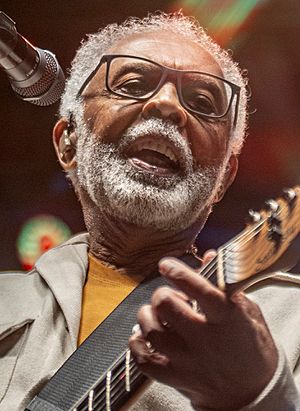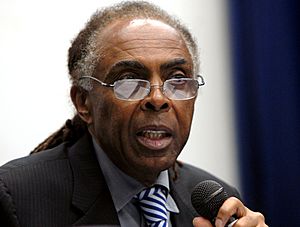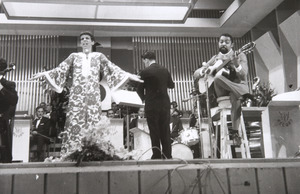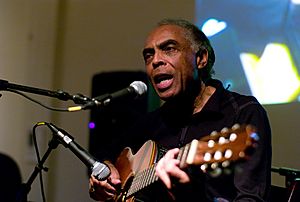Gilberto Gil facts for kids
Quick facts for kids
Gilberto Gil
|
|
|---|---|

Gilberto Gil, in 2022
|
|
| Born |
Gilberto Passos Gil Moreira
26 June 1942 |
| Education | Federal University of Bahia (BBA) |
| Occupation |
|
| Political party |
|
| Spouse(s) |
Belina de Aguiar
(m. 1965; separated 1967)Nana Caymmi
(m. 1967; separated 1968)Sandra Gadelha
(m. 1969; div. 1980)Flora Giordano
(m. 1981) |
| Children | 8 (including Preta) |
| Musical career | |
| Genres |
|
| Instruments | |
| Years active | 1959–present |
| Labels | |
| Associated acts |
|
Gilberto Passos Gil Moreira (born 26 June 1942), known as Gilberto Gil, is a famous Brazilian singer, songwriter, and politician. He is known for his creative music and for working to make the world a better place. From 2003 to 2008, he was Brazil's Minister of Culture. This means he was in charge of all things related to art and culture for the country.
Gil's music mixes many different styles. These include rock, Brazilian music like samba, African music, and reggae. He started playing music when he was a child. As a teenager, he joined his first band.
He began his career playing bossa nova music. Soon, he started writing songs about important social issues. He was a key leader in the música popular brasileira and tropicália music movements in the 1960s. He worked with other artists like Caetano Veloso.
In 1969, Gil and Veloso were held for nine months by the Brazilian government. They were then told to leave the country. Gil moved to London, England. He returned to Bahia in 1972 and kept making music. He also worked as a politician and spoke up for the environment.
His album Quanta Live won a Grammy Award in 1999. His album Eletracústico won another Grammy in 2005.
Contents
Early Life and Music (1942–1963)
Gilberto Gil was born in Salvador, Brazil. He spent much of his childhood in Ituaçu, a small town in the countryside. His father was a doctor, and his mother was a teacher. Gil went to a Marist Brothers school as a young boy. He stayed in Ituaçu until he was nine, then moved back to Salvador for high school.
Gil loved music from a very young age. He once said that when he was two, he told his mother he would be a musician or president. He grew up listening to forró music from his home region. He also enjoyed watching street performers in Salvador.
He started playing drums and trumpet by listening to the radio. Gil's mother strongly supported his musical dreams. She bought him an accordion when he was ten. He went to music school in Salvador for four years.
At first, Gil played classical music on the accordion. But he soon became more interested in Brazilian folk and popular music. He was especially inspired by singer and accordion player Luiz Gonzaga. Gil started singing and playing like Gonzaga. He felt connected to Gonzaga because he sang about the world around him.
While in Salvador, Gil discovered the music of Dorival Caymmi. Caymmi's music showed him the beach-style samba of Salvador. Gonzaga and Caymmi were very important influences on Gil. He also learned about other music styles, like American big band jazz and tango.
In high school, Gil joined his first band, Os Desafinados ("The Out of Tunes"). He played accordion, vibraphone, and sang. The band was influenced by American rock and roll and singing groups from Rio de Janeiro. After this, inspired by Brazilian musician João Gilberto, he chose the guitar as his main instrument. He then began to play bossa nova.
Musical Journey (1963–Present)
Gilberto Gil met guitarist and singer Caetano Veloso in 1963. They started working together, releasing songs and EPs. In 1964, Gil, Veloso, Maria Bethânia, Gal Costa, and Tom Zé performed together. Their show was called Nós, por Exemplo ("Us, for Example"). Gil became a musical director for the concert series.
In 1968, Gil worked with these artists again on the album Tropicália: ou Panis et Circenses. This album was inspired by The Beatles' Sgt. Pepper's Lonely Hearts Club Band. Gil says this album marked the start of the tropicália movement. Tropicália mixed Brazilian music like bossa nova with rock and roll from other countries. The Brazilian government at the time saw this new music as a threat.
In the early 1960s, Gil earned money by selling bananas and writing jingles for TV ads. He also worked briefly for Unilever. In 1965, he moved to São Paulo. His song "Louvação" became a hit when Elis Regina released it. His first hit as a solo artist was "Aquele Abraço" in 1969. Gil also appeared on many TV shows with other "tropicalistas."
A Time of Change
In February 1969, Gilberto Gil and Caetano Veloso faced difficulties with the Brazilian government. Their artistic expressions were seen as challenging the authorities. They were held for a few months and then told to leave the country. Gil felt the government saw his art as something new and hard to understand, which they found dangerous.
While held, Gil started to meditate and learn about Eastern philosophy. He wrote four songs during this time. One of them was "Cérebro Electrônico" ("Electronic Brain"). After this, Gil and Veloso moved to London, England. They played a final concert in Brazil before leaving.
In London, Gil lived with Veloso and their families. He was involved in the 1971 Glastonbury Free Festival. He also discovered reggae music there, listening to artists like Bob Marley. He was part of London's rock music scene, performing with bands like Yes and Pink Floyd. He also recorded his album Gilberto Gil (Nêga) while in London.
When Gil returned to Bahia in 1972, he focused on his music and protecting the environment. He released Expresso 2222 that same year, which had two popular songs. Gil toured the United States and recorded an English album. He continued to release many albums throughout the 1970s.
In the early 1970s, Gil helped bring back the Afro-Brazilian afoxé tradition in Carnaval. He joined the Filhos de Gandhi ("Sons of Gandhi") group, which was only for black Brazilians. Gil wrote a song about them called "Patuscada de Gandhi." His involvement helped these groups become more popular.
In the late 1970s, he visited Africa, going to Senegal, Ivory Coast, and Nigeria. He worked with Jimmy Cliff and released a cover of "No Woman, No Cry" with him in 1980. This song became a number one hit and helped bring reggae to Brazil.
In 1996, Gil's song "Refazenda" was part of the album Red Hot + Rio, which raised money for AIDS research. In 1998, the live version of his album Quanta won a Grammy Award for Best World Music Album. In 2005, he won another Grammy for Eletracústico. He also received the Polar Music Prize in Sweden and the Légion d'honneur from France.
In 2010, he released Fé Na Festa, an album dedicated to forró music. In 2013, Gilberto Gil appeared in a documentary called Viramundo: a musical journey with Gilberto Gil. His 2018 album OK OK OK was named one of the best Brazilian albums of that year.
Political Work (1987–Present)
|
Gilberto Gil
|
|
|---|---|

Gilberto Gil on 11 September 2007.
|
|
| Minister of Culture | |
| In office 1 January 2003 – 30 July 2008 |
|
| President | Luiz Inácio Lula da Silva |
| Preceded by | Francisco Weffort |
| Succeeded by | Juca Ferreira |
| Councillor of Salvador | |
| In office 1 January 1989 – 1 January 1993 |
|
| Constituency | At-large |
| Personal details | |
| Political party | PV (1990–present) |
| Other political affiliations |
PMDB (1988–90) |
| Signature | |
Gilberto Gil sees his role in government as a manager or administrator. He believes politics is important. His political career started in 1987 when he was elected to a local position in Bahia. He became the culture secretary for Salvador. In 1988, he was elected to the city council. He also became the city commissioner for environmental protection.
He left this office after one term and did not run for the national government. In 1990, Gil joined the Green Party. During this time, he started an environmental group called Onda Azul ("Blue Wave"). This group worked to protect Brazil's waters. He continued his music career at the same time. In 1992, he stepped back from politics for a while after releasing his successful album Parabolicamará.
In 2001, Gil became a Goodwill Ambassador for the United Nations' Food and Agriculture Organization (FAO). He had already supported the organization before this.
When President Luiz Inácio Lula da Silva became president in 2003, he chose Gil as Brazil's new Minister of Culture. Gil was the second black person to serve in the country's cabinet. This choice was talked about a lot.
As Minister, Gil supported a program called Culture Points. This program gave money to help people in poor areas get music technology and education. Gil said this program helped young people become designers and use media. He also wanted to create an online library of free Brazilian music. After Gil became Minister, the culture department's spending increased a lot. In 2008, Gil left his role as Minister to focus more on his music.
Personal Life
Gilberto Gil has been married four times. He has two daughters, Nara and Marilia, with his first wife, Belina Aguiar. He was then married to singer Nana Caymmi. His third wife was Sandra Gadelha, and they had three children: Pedro, Preta, and Maria. Sandra was with him during tough times in Brazil. His fourth wife is Flora Giordano. They have three children: Bem, Isabella, and Jose.
His first son, Pedro Gil, who was a drummer, passed away in a car accident in 1990. Preta Gil, an actress and singer, is his daughter with Sandra Gadelha.
Gil's beliefs have changed over his life. He was a Christian but later explored Eastern philosophy and African spirituality. He is now an agnostic, meaning he is not sure if God exists. He practices yoga and is a vegetarian.
Musical Style and Influences
Gilberto Gil sings in a high voice, but he can also sing in a lower voice or use scat singing (singing with sounds instead of words). His songs are about many things, from philosophy to religion and folktales.
His music mixes many different styles. When he first started, he listened to The Beatles and street performers in Bahia. In his early years as a musician, Gil played a mix of traditional Brazilian styles with two-step rhythms, like baião and samba. He said his first music was very traditional, not experimental at all.
As a leader of tropicália, Gil's music was influenced by rock and even punk. He was especially inspired by rock pioneer Jimi Hendrix. This had a big impact on Brazilian music. After the tropicália movement in the 1960s, Gil became more interested in black culture, especially Jamaican reggae. He saw reggae as a way to share important messages with the world.
In 1976, Gil visited Lagos, Nigeria, for a festival. He met musicians like Fela Kuti and Stevie Wonder. He was inspired by African music and later added styles like juju and highlife to his own songs. His 1977 album Refavela was heavily influenced by Africa and reggae. When he returned to Brazil, he focused on Afro-Brazilian culture.
In the 1980s, his music also included dance styles like disco and soul. However, Gil said his 1994 album Acoustic was not a new direction. He had performed unplugged before with Caetano Veloso. He finds acoustic playing simpler and closer to the music's roots.
Some people have criticized Gil for mixing traditional Brazilian music with global music. He has tried to stay true to Bahian styles while also reaching a wider audience. People in Bahia were more open to his mixed styles, while some in southeast Brazil found it different.
Discography
- 1967: Louvação
- 1968: Gilberto Gil (with Os Mutantes)
- 1968: Tropicália: ou Panis et Circencis (with Caetano Veloso, Gal Costa, Os Mutantes)
- 1969: Gilberto Gil (Cérebro Eletrônico)
- 1970: "Copacabana Mon Amour"
- 1971: Gilberto Gil (Nêga)
- 1972: Barra 69: Caetano e Gil Ao Vivo na Bahia
- 1972: Expresso 2222
- 1974: Gilberto Gil Ao Vivo
- 1975: "Gil e Jorge: Ogum Xangô" (with Jorge Ben)
- 1975: Refazenda
- 1976: Doces Bárbaros (with Gal Costa, Caetano Veloso and Maria Bethânia)
- 1977: Refavela
- 1978: Gilberto Gil Ao Vivo em Montreux
- 1978: Refestança (with Rita Lee)
- 1979: Nightingale
- 1979: Realce
- 1981: Brasil (João Gilberto album featuring Caetano Veloso, Gilberto Gil and Maria Bethânia)
- 1981: Luar (A Gente Precisa Ver o Luar)
- 1982: Um Banda Um
- 1983: Extra
- 1984: Quilombo (Trilha Sonora)
- 1984: Raça Humana
- 1985: Dia Dorim Noite Neon
- 1987: Gilberto Gil em Concerto
- 1987: Soy Loco por Ti America
- 1987: Trem Para As Estrelas (Trilha Sonora)
- 1988: Ao Vivo em Tóquio
- 1989: O Eterno Deus Mu Dança
- 1991: Parabolicamará
- 1994: Acoustic
- 1994: Tropicália 2 (with Caetano Veloso)
- 1995: Esoterico: Live in USA 1994
- 1995: Oriente: Live in Tokyo
- 1996: Em Concerto
- 1996: Luar
- 1997: Indigo Blue
- 1997: Quanta
- 1998: Ao Vivo em Tóquio
- 1998: O Sol de Oslo
- 1998: O Viramundo (Ao Vivo)
- 1998: Quanta Live
- 2000: Me, You, Them
- 2001: Gil & Milton (with Milton Nascimento)
- 2001: São João Vivo
- 2002: Kaya N'Gan Daya
- 2002: Z: 300 Anos de Zumbi
- 2004: Eletracústico
- 2005: Ao Vivo
- 2005: As Canções de Eu Tu Eles
- 2005: Soul of Brazil
- 2006: Gil Luminoso
- 2006: Rhythms of Bahia
- 2008: Banda Larga Cordel
- 2009: Bandadois
- 2010: Fé na Festa
- 2010: Fé na Festa ao vivo
- 2011: Gilberto + 10
- 2012: Especial Ivete Caetano Gilberto ao vivo
- 2013: Concerto de Cordas & Maquinas de Ritmo
- 2014: Gilbertos Samba
- 2015: Gilbertos Samba ao vivo
- 2016: Dois Amigos (with Caetano Veloso)
- 2017: Trinca de Ases (with Gal Costa and Nando Reis)
- 2018: OK OK OK
- 2022: Em Casa com os Gils
Awards and Recognitions
| Year | Work | Award | Result |
|---|---|---|---|
| 1981 | N/A | Anchieta Medal—São Paulo City Council | Won |
| 1986 | N/A | The Gold Dolphin—Government of the State of Rio de Janeiro | Won |
| 1990 | N/A | Ordre des Arts et des Lettres—Ministry of Culture of France | Won |
| 1990 | N/A | Commendator of the Order of Rio Branco | Won |
| 1997 | N/A | Ordre national du Mérite | Won |
| 1999 | Quanta Live | Grammy Award—Best World Music Album | Won |
| 1999 | N/A | Order of Cultural Merit—Ministry of Culture | Won |
| 1999 | N/A | UNESCO Artist for Peace—United Nations | Won |
| 2001 | Eu Tu Eles | Cinema Brazil Grand Prize—Best Music | Nominated |
| 2001 | As Canções De Eu, Tu, Eles | Latin Grammy Award—Brazilian Roots/Regional Album | Won |
| 2001 | N/A | Goodwill Ambassador—Food and Agriculture Organization | Won |
| 2002 | Viva São João! | Passista Trophy—Long Documentary – Best Score | Won |
| 2002 | São João Vivo | Latin Grammy Award—Best Brazilian Roots/Regional Album | Won |
| 2003 | N/A | Latin Recording Academy Person of the Year | Won |
| 2005 | Eletracústico | Grammy Award—Best Contemporary World Music Album | Won |
| 2005 | N/A | Polar Music Prize | Won |
| 2005 | N/A | Légion d'honneur | Won |
| 2016 | Gilbertos Samba Ao Vivo | Grammy Award for Best World Music Album | Nominated |
| 2019 | Ok Ok Ok | Latin Grammy Award for Best MPB Album | Won |
See also
 In Spanish: Gilberto Gil para niños
In Spanish: Gilberto Gil para niños
- Vamos Fugir (pt)
- Sítio do Picapau Amarelo (pt)



